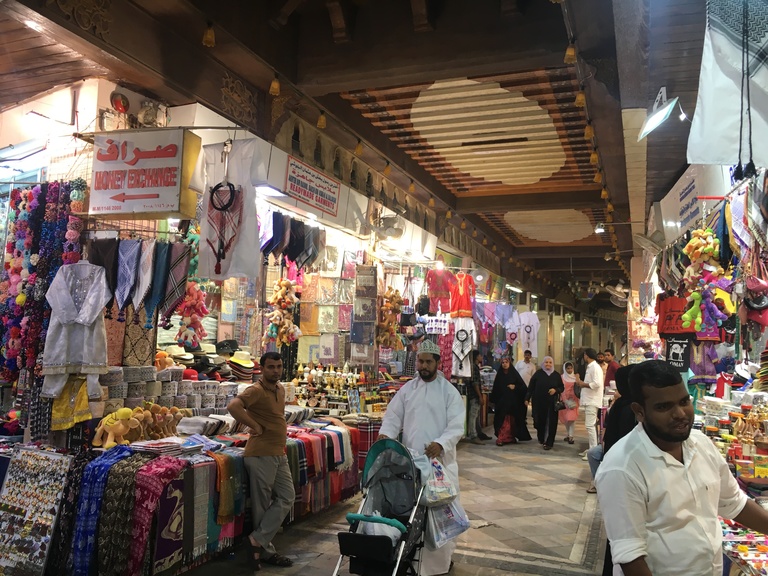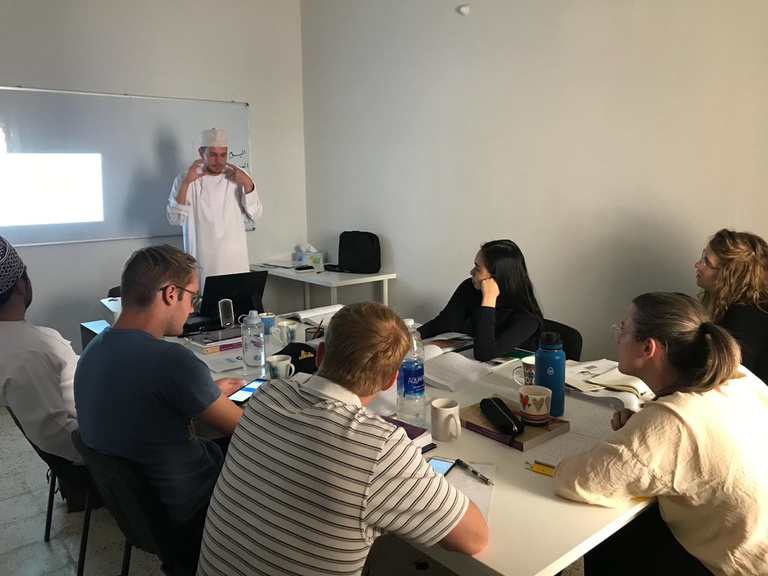
As-salaamu ‘alaykum and hello again on this lovely 112°F morning in Ibri, Oman!
I am now deep into my intensive Arabic language studies at the Noor Majan Training Institute (pronounced “Noor Magán”), so it’s about time I give a glimpse into academic life here in the sultanate.
After an hours-long placement exam and a phone interview that left me questioning my ability to even put together sentences in Arabic, I was placed in level 3 out of 5. Students in level 1 typically have just a year of low-intensity studies under their belts, and level 5 students largely are either heritage speakers or those who’ve spent extensive time in the region. I’ve come to appreciate the wonderful diversity of themes we explore in my classes, and have been excited to share more about it.
Class Schedule
Class 1: Arab Media (8:30-9:30) : This is a pretty engaging class where we look at Arab media, from the news to popular culture. Each week is a new theme, such as “Arab theater,” or the “occupation of Palestine.”
Class 2: Omani Dialect (9:30-10:30) : My favorite class, focused on regional dialect.
Class 3: Modern Standard Arabic (11:00-1:00) : This is a brutal one…it’s grammar and vocabulary heavy, much like my classes in the U.S.
Twice weekly 5-minute presentations are cornerstones of both my dialect and MSA class.
Yes, it is very stressful to speak in Arabic for 5 minutes, and no, I do not look forward to presentation day. Sometimes I feel like I’m learning 1.5 languages because dialectal vocabulary is so radically different from the standardized Arabic used to facilitate professional communication across the Arab world. As an example, here is an excerpt from the class presentation I gave today on my trip to Sharqiyah in both standard and dialectal forms:
English: On Sunday, we went to the Sharqiyah desert where we stayed at a great hotel.
MSA: youm al-aHad dhahabnaa ilaa aS-SaHraa’ ash-sharqiyyah aendamaa nazilnaa fii funduq mumtaaz.
Omani Dialect: yoom al-aHad rooHnaa las-seeH ash-sharqiyyah waqt bitnaa fii funduq ghaawii.
Generally, I like giving my weekly presentations on heavy international political themes. I’m still not sure if my classmates appreciate the sobering dose of reality I serve between presentations on American foods and allegedly haunted locales, but I think it will grow on them with time.
I have found that most all Omanis are hesitant or even reluctant to talk politics of any sort. Indeed, Oman itself is a largely apolitical country due to the Sultan’s position as the national authority and laws that make slandering His Majesty Sultan Qaboos bin Said a serious criminal offense. The Sultan’s portrait is ubiquitous in public spaces, and his likeness graces all seven banknotes of the Omani rial. 2020 will mark the 50th anniversary of Sultan Qaboos’s rise to power.
While a brutal war rages on next door in Yemen and a regional cold war chills the waters between Iran and Saudi Arabia, Oman has remained entirely peaceful. The required 1 hour safety lecture we received from the U.S. Embassy was basically a crash course on why to not visit the Yemeni border, and a reassertion that we were probably safer in Oman than anywhere in America. Oman has never suffered a bombing or terror attack in its modern history.
Contrary to many stereotypes of the Middle East, all Omanis I have spoken to are very sensitive to violence and understandably disgusted with the current state of the region. One man I spoke to noted his country would do anything to maintain peace, and the Sultan is credited for driving a foreign policy of national preservation and non-intervention that has allowed Oman to skirt the troubles of its neighbors. Oman is one of the only countries in the region that maintains cordial relations with both Iran and Saudi Arabia.
As fun as academics and analysis are, I am beginning to make a break from the monotonous life of the institute where I eat, sleep, attend class, and study every day. Meeting Omanis is HARD in Ibri. At least at first. After all, we are in a place the size of Iowa City surrounded by little more than desert farms for 2.5 hours in all directions until you hit the outskirts of Dubai and Muscat. For that reason, we were all assigned language partners that are required to meet with us three times weekly and take us home on many weekends. I have begun to branch out much further though, regularly meeting Omanis through Instagram (of all places) and social events where I pick up Whatsapp numbers like candy on Halloween. It’s a great time all around, and I’ve been trying to get out with Omanis every other night so I can be practicing my dialectal Arabic skills, which are nearly impossible to learn in a classroom setting.
Earlier this week, a couple friends picked me up and drove 20 kilometers into the desert of a neighboring wilaya (state). We sat out on the desert floor surrounded by mountains and the starry sky and talked, ate some food, and just enjoyed the (somewhat) unoppressive nighttime air. It honestly made me realize that learning Arabic is not as hopeless as I felt it was during the last few weeks and that I can communicate on a level I was not even close to on day one. And I suppose that’s what this summer is going to be all about.


Interested in going abroad? Learn more about first steps